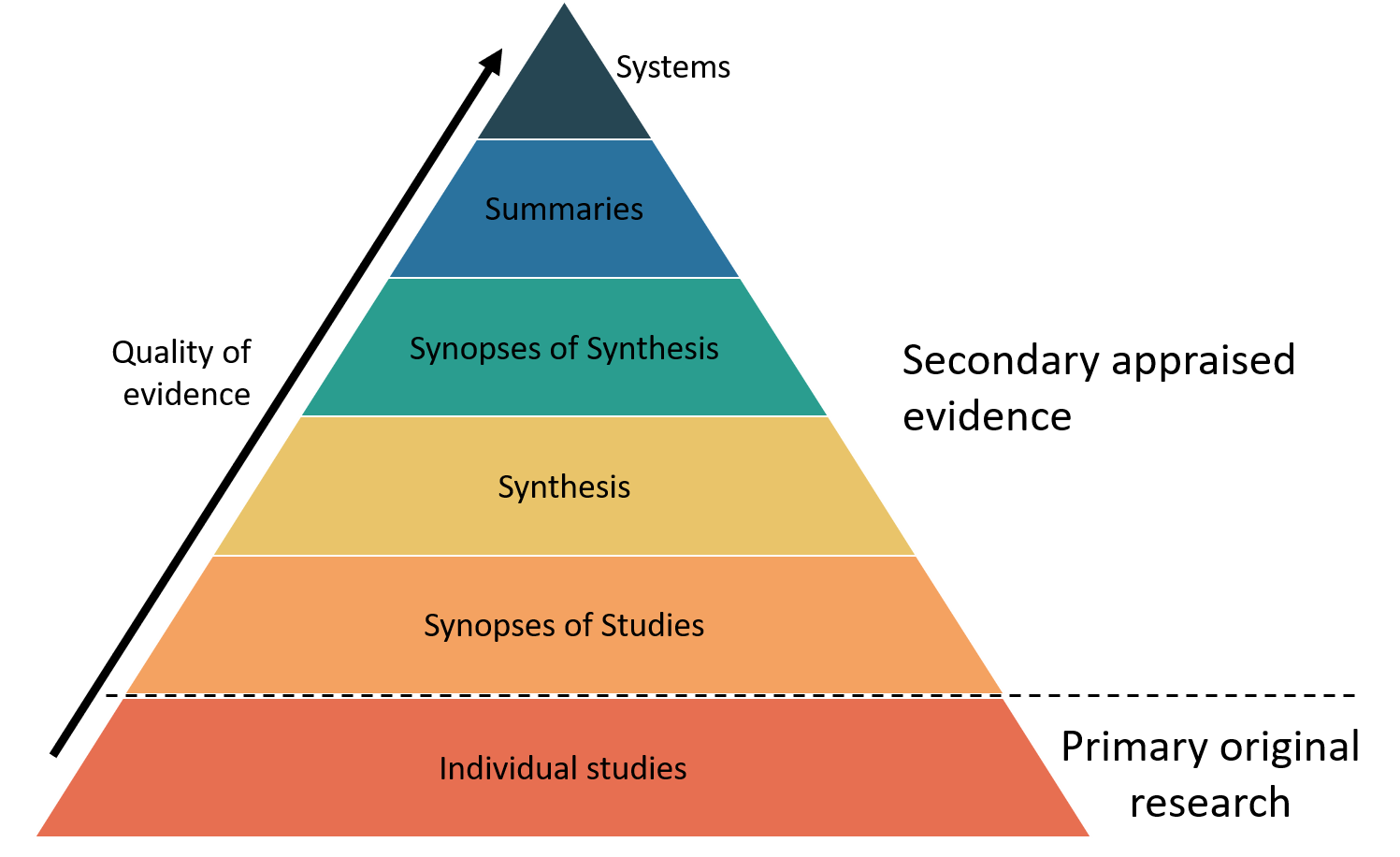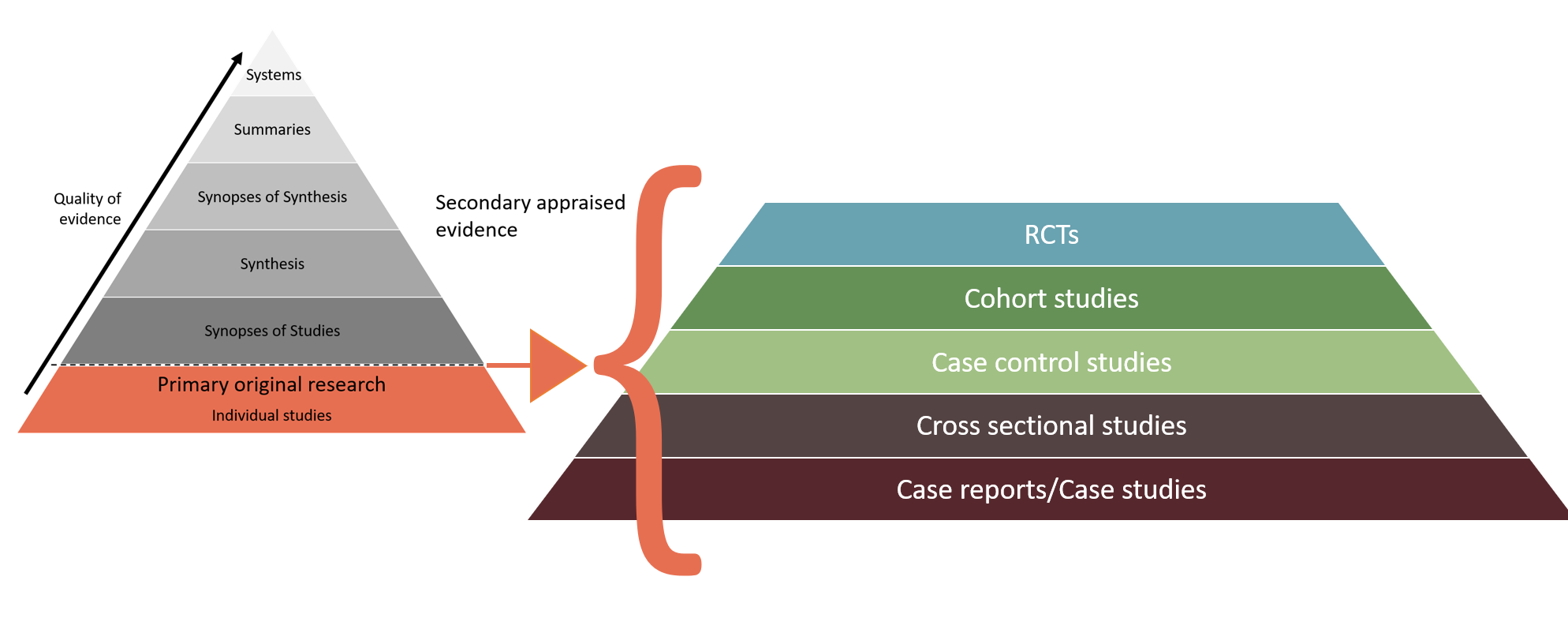What is Evidence Based Practice?
Using the best evidence available
Social workers who utilize evidence to inform their practice, need to learn research skills to be able to consult the best evidence available to them.
Depending on the type of clinical question (risk, diagnosis, treatment, prognosis, prevention, harm), the level of hierarchical evidence available will vary from the lowest levels, such as expert opinion, through to individual case studies, cohort studies, clinical trials and, finally, randomized trials and meta-analyses at the highest level.
Evidence based practice is the integration of practitioner expertise, patient values, and the best research evidence into the decision making process for patient care. Practitioner expertise refers to the social work practitioner’s cumulated experience, education and clinical skills. The patient brings to the encounter their own personal and unique concerns, expectations, and values. The best evidence is usually found in clinically relevant research that has been conducted using sound methodology (Sackett et al., 1996).
5 steps of EBP
Five steps of evidence based practice
- Ask the clinical question (PICO)
Convert the need for information into an answerable question. Take time to formulate a clear and detailed question. - Acquire the evidence
Find the best evidence to answer the question. Search for the best possible evidence from high quality, peer-reviewed sources. - Appraise the evidence
Critically appraise the evidence for validity, impact and applicability. - Apply the evidence
Apply the evidence in combination with clinical experience and patient values and circumstances. - Assess the process
Assess the effectiveness and efficiency of our process and find ways to improve for next time
Adapted from Straus et al. (2019).
Ask the clinical question – types of evidence and PICO
Create a clinical question using PICO
In formulating an answerable question, a good technique to use is to take your clinical problem and apply the PICO method:
P – Population or Patient group
I – Intervention or Indicator
C – Comparator or Control
O – Outcome
P: Population / Patient
- Who or What? Patient/client, Population, Problem.
- How would you describe a group of patients/clients similar to your group?
- What are the most important characteristics? Primary problem; illness; co-existing conditions.
- Consider gender, sexual preference, religion, abilities, age and/or race/ethnicity of a patient as this may be relevant to the intervention choice.
I: Intervention / Indicator
- Which main intervention type are you considering?
- What do you want to do for the patient/client? Engage in treatment, recommend service or program?
- What factor might influence outcomes for the patient/client?
- What exposures has the patient experienced? Trauma, loss, violence, racism.
C: Comparator / Control
- What is the main alternative? Comparison or intervention?
- What is the main alternative to compare with the intervention?
- Are you trying to decide between? Two interventions or several different?
- Your PICO question may not always need a specific comparison.
O: Outcome
- What are you and your patient/client trying to accomplish, measure, improve, effect, achieve?
- What would success look like for your patient/client?
- What can you hope to accomplish, measure, improve, decrease, or affect?
- What are you trying to do for the patient? Relieve or eliminate the symptoms; reduce the number of adverse events; improve function or test scores.
Example
Presenting problem: An adult non-binary client asks what may help with their depression.
Answerable clinical question:
P – Non-binary adults
I – Does Dialectical Behavioral Therapy
C – Compared to not engaging in therapy
O – Reduce the incidence of depression
Levels of evidence and types of questions
Levels of evidence

Answering clinical questions requires high quality evidence, so levels of evidence (or hierarchies of evidence) and research study designs are used in EBP to help identify the best possible evidence easily.
The 6 S levels of evidence (shown in these diagrams) show that secondary sources that have appraised and synthesised many individual studies are considered higher quality sources, compared to individual research studies (DiCesno, Bayley & Haynes, 2009; ehealth NSW, 2018). The highest level of evidence available should be what you use to answer clinical questions.
When individual studies are used, the research design of the studies is important to understand. Using higher quality research designs helps reduce bias, and increase the reliability of research, which helps support clinical decision making. However, many research questions can’t be answered with study designs like a Randomized Control Trial (RCT), so the type of question you are asking must be taken into account.

Diagrams adapted from eHealth NSW (2018).
Types of questions
Different types of clinical questions will require different levels of primary evidence to find appropriate, reliable answers. Understanding the type of clinical question you are asking and the appropriate research methodologies to answer it will also help you decide where to search for evidence, an how to appraise the evidence.
| Type of question | Explanation | Types of evidence to answer the question |
|---|---|---|
| Therapy (treatment) | Questions about the effectiveness of interventions in improving outcomes for patients. Includes medications, surgeries, or service delivery | Randomised Controlled Trial (RCT) |
| Prevention | Questions about reducing the chance of disease, identifying risk factors or screening | RCT or Prospective study |
| Diagnosis | Questions about the validity of diagnostic or screening tests | RCT or Cohort Study or Cross-sectional study |
| Prognosis | Questions about the likely course of a condition | Cohort Study or Case-Control Series or Longitudinal study |
| Etiology (causation) | Questions about determining if a harmful factor is related to the development or course of a condition | Cohort Study |
| Meaning | Questions about the patient experience | Qualitative Study |
Find the evidence – some sources that can help you
Clinical evidence databases
-
A specialized search within PubMed that focuses on evidence based clinical studies, systematic reviews, and medical genetics.EBP Registries
The following is a list of some EBP registries you may find helpful for your search. Of course, a library database search is also always helpful, but occasionally EBP registries can be helpful as they identify specific interventions and usually provide an evaluation of the research used to support that EBP.
Registries may be developed by federal or state governments, foundations, trade groups, or other organizations focused on improving quality and promoting accountability for taxpayer dollars. The Substance Abuse and Mental Health Services Administration (SAMHSA), for example, had developed the National Registry of Evidence-Based Programs and Practices (NREPP) in an effort to provide the public with reliable information on mental health and substance abuse interventions. However, in 2018, the Trump administration ordered the database to be shut down.
Following a change in administration, SAMHSA has a limited amount of information available, but not the full registry it once had. However, below are lists of several other databases that can be used to search for EBPs by population, practice area problem identification.
Blueprints for Healthy Youth Development http://www.blueprintsprograms.com
Provides a registry of evidence-based positive youth development programs designed to promote the health and well-being of children and teens. Blueprints programs are family, school, and community-based and target all levels of need — from broad prevention programs that promote positive behaviors while decreasing negative behaviors, to highly-targeted programs for at-risk children and troubled teens that get them back on track.
California Evidence-Based Clearinghouse for Child Welfare http://cebc4cw.org/
Provides a searchable database of child welfare related programs and a description and information on research evidence for specific programs. Also provides guidance on how to make critical decisions regarding selecting and implementing programs and tools and materials to provide support for choosing, implementing and sustaining a program.
Connecticut Department of Public Health: Where to Find Evidence Based Methods and Interventions
National Council on Aging Evidence-Based Programs: https://www.ncoa.org/evidence-based-programs
Lists programs that have been approved through the NCOA Evidence-Based Program
- Review Process. Programs are selected based on empirical evidence of improving health promotion and disease prevention among older adults.
NY State Evidence-based programs
https://oasas.ny.gov/providers/evidence-based-prevention-programs
Evidence-Based Practices for Substance Use http://lib.adai.washington.edu/ebpsearch.htm
A small, but growing, database of evidence-based interventions for treating substance use disorders. Interventions were selected according to criteria described on the About EBP page. Each record in the database includes a description of the intervention and its implementation, populations for which it has been shown to be effective, references to supporting literature, the availability of instructional manuals, and author/developer notes and other useful information.
The Campbell Library http://www.campbellcollaboration.org/lib
Promotes positive social and economic change through the production and use of systematic reviews and other evidence syntheses for evidence-based policy and practice. It includes studies in the areas of crime and justice, education, international development, knowledge translation and implementation, methods, nutrition and social welfare.
The Cochrane Library http://www.thecochranelibrary.com/view/0/index.html
The Cochrane Database of Systematic Reviews (CDSR) is the leading resource for systematic reviews in health care. The CDSR includes Cochrane Reviews (the systematic reviews) and protocols for Cochrane Reviews as well as editorials. It is a collection of six databases that contain different types of high-quality, independent evidence to inform healthcare decision-making, and a seventh database that provides information about Cochrane groups..
Suicide prevention resource center:
Washington State Institute for Public Policy:
References
DiCesno, A., Bayley, L., & Haynes, B. (2009). Accessing pre-appraised evidence: fine-tuning the 5S model into a 6S model. Evidence Based Nursing, 12(4). https://doi.org/10.1136/ebn.12.4.99-b
eHealth NSW. (2018). Clinical Information Access Portal (CIAP) EBP Learning Modules. https://www.ciap.health.nsw.gov.au/training/ebp-learning-modules/module1/index.html
Sackett, D. L., Rosenberg, W. M., Gray, J. A., Haynes, R. B., & Richardson, W. S. (1996). Evidence based medicine: what it is and what it isn’t. BMJ, 312(7023), 71–72. https://doi.org/10.1136/bmj.312.7023.71
Straus, S. E., Glasziou, P., Richardson, W. S., & Haynes, R. B. (2018). Evidence-based medicine: How to practice and teach EBM (5th ed.). Elsevier.
Sun, L. H., & Eilperin, J. (2018, January 12). Trump administration freezes database of addiction and mental health treatments. The Washington Post. Retrieved July 7, 2022, from https://www.washingtonpost.com/national/health-science/trump-administration-freezes-database-of-addiction-and-mental-health-programs/2018/01/10/ed421654-f577-11e7-beb6-c8d48830c54d_story.html
